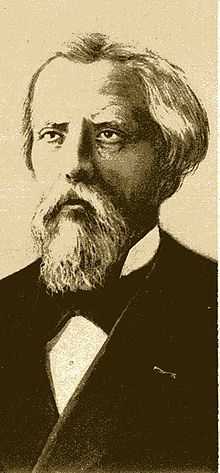Philippe Édouard Léon Van Tieghem

Philippe Édouard Léon Van Tieghem (19 April 1839 – 28 April 1914) was a French botanist born in Baillleul in the département of Nord.
After obtaining his baccalauréat in 1856, he studied at the École Normale Supérieure, and after receiving agrégation, he worked in the laboratory of Louis Pasteur (1822–1895). Here he performed research involving the cultivation of mushrooms. He is credited with creation of the eponymous "Van Tieghem cell", a device mounted on a microscope slide that allows for observing the development of a fungus' mycelium.
In 1864 he earned his doctorate in physical sciences with a thesis titled Recherches sur la fermentation de l'urée et de l'acide hippurique, and two years later obtained a doctorate in natural history. From 1873 to 1886, he taught classes at the École centrale des arts et manufactures, and from 1878 to 1914, was a professor at the Muséum national d'histoire naturelle. Within this time period (1899–1914), he was also an instructor at the Institut agronomique in Paris.
In 1871 he became a member of the Société philomathique de Paris, and in 1876 gained membership to the Académie des sciences. In 1873 he translated botanical writings of Julius von Sachs from German into French as Traité de botanique conforme à l'état présent de la science. Other noted publications by Van Tieghem are as follows:
- Recherches comparatives sur l'origine des membres endogènes dans les plantes vasculaires, 1889 - Comparative research on the origin of endogenous members of vascular plants.
- Eléments de botanique, 1898 - Elements of botany.
- L'Oeuf des Plantes considéré comme base de leur Classification, 1901.
- Nouvelles observations sur les Ochnacées, 1903 - New observations on Ochnaceae.
- Sur les Luxembourgiacées, 1904 - On Luxemburgiaceae.
- Travaux divers: Pistil et fruit des Labiées, Boragacées et des familles voisines: Divers modes de Placentation: Anthères hétérogènes. : Une graminée à rhizome schizostélique: A propos de la Strasburgérie, 1907 - Diverse works, Pistil and fruit of Labiatae, Boraginaceae, etc.[1]
In 1876 he was the first to describe blastomycosis, a fungal infection that is also known as "Gilchrist disease", named after Thomas Casper Gilchrist (1862–1927), who published a treatise on the condition in 1896.
References
- ↑ Sociétés savantes (publications)
- ↑ "Author Query for 'Tiegh.'". International Plant Names Index.
External links
- Biography (in French) Institut Pasteur, Repères chronologiques.
- Gilchrist disease @ Who Named It
- Merriam Webster Dictionary Van Tieghem cell
|